Design and Experiments of Directional Core Drilling Tool
Abstract
1. Introduction
2. Structure and Process Principles of DCDT
- (1)
- Deployment of inner tube assembly: During directional drilling, borehole trajectory may involve vertical, inclined, or horizontal sections, and free-fall deployment of the inner tube assembly may not reach the designated position. Therefore, it must be pumped to the designated position at the bottom of hole using a mud pump. After the inner tube assembly is positioned, drilling fluid flows through the PDM, driving its rotation. Rotational torque is transmitted through a spline to a torque transmission pipe, driving the core bit. An eccentric bearing assembly isolates movement of the torque transmission pipe and outer pipe, permitting only the coring bit to rotate, thus reducing working torque of the PDM. Once the PDM reaches its position, mud pump pressure increases, signaling that the inner tube assembly is properly positioned.
- (2)
- Core drilling: Once the inner tube assembly is deployed, the coring process begins. During drilling, the azimuth and dip angle of the hole are adjusted according to the designed drilling trajectory. It is crucial that axes of both inner and outer tube assemblies remain consistent with borehole axis, ensuring smooth flow of core samples into core barrel while minimizing risks of tool breakage, wear, and core loss [28].
- (3)
- Recovery of Inner Tube Assembly: When the core run footage reaches the length of core barrel, the inner tube assembly can be fished. The coring tool is retrieved using a fishing tool, and as the fishing tool is lifted, the coring tool is released from the latch head assembly. The entire coring tool is then retrieved to the borehole head. The tool is disassembled to extract the core from the core barrel. The tool is then reassembled, and the above steps are repeated for continued core processes.
3. Deflecting Capability and PDM Power of DCDT
3.1. Calculation of Max Deflecting Ability of DCDT
3.2. Power Calculation of PDM
4. HSBS Simulation
4.1. Model Parameter Setting and Mesh Generation
- (1)
- The entire HSBS was regarded as a rigid body.
- (2)
- All deformations occurring during the simulation were assumed to be elastic deformations.
- (3)
- Factors such as temperature and vibration during the drilling process were neglected.
4.2. Effect of Different Angles on the Stress-Strain of HSBS
4.2.1. Stress–Strain Effects of Different Angles on HSBS in Sliding Drilling Mode
4.2.2. Stress–Strain Effects of Different Angles on HSBS in Hybrid Drilling Mode
4.3. Effect of Lateral Forces on Stress–Strain of HSBS
4.4. Effect of Axial Force on Stress–Strain of HSBS
5. Experiments and Discussion
5.1. DCDT Assembly Tests
5.2. Platform Tests
5.3. Core Drilling Tests of DCDT
6. Conclusions
- (1)
- In response to the demand for resource exploration and reserve expansion of submarine mineral resources, the structure and processes of DCDTs were proposed. By utilizing wire-line coring, this method enables continuous core retrieval during directional drilling, facilitating precise acquisition of three-dimensional subsurface core samples.
- (2)
- Through simulation, the impacts of the bend angle, lateral force, and axial force on the stress–strain of the HSBS system during slide/hybrid drilling were analyzed. The results revealed the following: ① an increase in the bend angle led to a corresponding rise in the maximum equivalent stress and strain, with the bend point identified as a vulnerable weak zone. ② Notably, lateral force proved to be a critical determinant, while the effect of axial force was found to be negligible. These findings show that it is very necessary to place emphasis on lateral force in drilling processes. And reinforcement design should be carried out in the stress–strain concentration area.
- (3)
- Through the platform tests and core drilling experiments of the DCDT prototype, the results indicated that DCDT performance was well and had the conditions for drilling experiments. The total length of obtained cores was 5.15 m. In hybrid drilling processes, the maximum recovery rate was 91.67%, while the core recovery rate was only 55–60% in slide drilling processes, and the calculated build-up rate could reach 7.5°/30 m. These studies provide technical support for the optimization and improvement of directional continuous coring drilling technology.
- (4)
- Although the initial tests successfully obtained directional cores, the number of tests was relatively small, and possible problems in the durability and fatigue resistance of DCDTs could not be revealed yet. Therefore, in the next step, we need to carry out more experiments to test its performance.
Author Contributions
Funding
Data Availability Statement
Conflicts of Interest
Abbreviations
| DCDT | Directional coring drilling tool |
| HSBS | Hollow single bend sub |
| PDM | Positive displacement motor |
| MWD | Measurement while drilling |
| BHA | Bottom hole assembly |
| WOB | Weight on bit |
References
- Tuo, S.; Wang, W. International Scientific Ocean Drilling 2050 Science Framework and Its Implications for Future Scientific Ocean Drilling Development. Adv. Earth Sci. 2022, 37, 1049–1053. [Google Scholar]
- Yang, J.; Li, L.; Song, Y.; Tong, G.; Zhang, M.; Zhang, H. Current status and prospects of offshore oil and gas drilling technology development in China. Acta Pet. Sin. 2023, 44, 2308–2318. [Google Scholar]
- Cheng, H.; Zhang, Y.; Wang, Y.; Liu, C. Progress and understanding on geology-drilling engineering-mechanics coupling mechanism of ultra-deep directional wells. Pet. Reserv. Eval. Dev. 2024, 14, 593–599. [Google Scholar]
- Li, X.; Xiong, L.; Xie, W.; Gao, K.; Shao, Y.; Chen, Y.; Yu, Y.; Kou, B.; Lu, Q.; Zeng, J.; et al. Design and Experimental Study of Core Bit for Hard Rock Drilling in Deep-Sea. J. Mar. Sci. Eng. 2023, 11, 306. [Google Scholar] [CrossRef]
- Freudenthal, T.; Wefer, G. Shallow Drilling in the Deep Sea: The Sea Floor Drill Rig MEBO. In Proceedings of the OCEANS 2009—Europe Conference, Bremen, Germany, 11–14 May 2009; pp. 11–14. [Google Scholar]
- Zeng, Z.; Qin, Y. Contribution of Ocean Drilling to the Study of Seafloor Hydrothermal Activity. Adv. Earth Sci. 2003, 18, 764–772. [Google Scholar]
- Song, J.; Ran, F.; Fang, Q.; Tian, P.; Zhang, H. The small-bore directional branch drilling technology in gold exploration of Zhenfeng County, Guizhou Province. Geol. Explor. 2024, 60, 1217–1227. [Google Scholar]
- Allouche, E.N.; Biggar, K.W.; Ariaratnam, S.T. Application of horizontal directional drilling for contaminated site characterization. In Proceedings of the 1st International Conference on Site Characterization (ISC 98), Atlanta, Georgia, 19 April 1998; pp. 341–346. [Google Scholar]
- Gao, D. Some research advances in well engineering technology for unconventional hydrocarbon. Nat. Gas Ind. 2021, 41, 153–162. [Google Scholar] [CrossRef]
- Yao, K.; Li, Q.; Fang, J.; Fang, P.; Wang, L.; Tian, D.; Chen, L.; Xu, C. Research on rotary geo-steering drilling technology and equipment in underground coal mine. Coal Sci. Technol. 2022, 50, 36–42. [Google Scholar]
- Li, Q.; Shi, Z.; Shi, H. The Application of directional drilling technology in coal mine. Coal Geol. Explor. 2014, 42, 85–88+92. [Google Scholar]
- DEVICO AS. Lockable Core Barrel Head for Drilling System and Survey Instrument Assembly Provided with a Connection Link for Arrangement in a Drilling System; DEVICO AS: Gatineau, QC, Canada, 2011; CA 2779932. [Google Scholar]
- DEVICO AS. Orientation System for Down-Hole Device; DEVICO AS: Gatineau, QC, Canada, 2022; CA 3204576. [Google Scholar]
- Shinmoto, Y.; Miyazaki, E.; Wada, K.; Yamao, M. Development of a continuous directional coring system for deep-sea drilling. SPE Drill. Complet. 2012, 27, 139–144. [Google Scholar] [CrossRef]
- Tsang, C.K.; Chau, S.F.; Chan, J. Sub-sea horizontal directional coring(HDC). Geo-Tech. Eng. 2016, 47, 31–36. [Google Scholar]
- Guo, Z.; Gao, D. An analysis of the bottom hole assembly(BHA) in directional drilling by considering the effects of the axial displacement. Comput. Model. Eng. Sci. 2013, 90, 65–76. [Google Scholar]
- Feng, T.; Kim, I.; Chen, D. Dynamic modeling of directional drill-string: A linearized model considering well profile. J. Dyn. Syst. Meas. Control. 2018, 140, 061005. [Google Scholar] [CrossRef]
- Shi, Z.; Dong, S.; Yang, J.; Xu, C.; Hao, S.; Li, Q.; Yao, K.; Liu, J.; Tian, D. Key technology of drilling in-seam directional borehole of 3000 m in underground coal mine. Coal Geol. Explor. 2019, 47, 2. [Google Scholar]
- Hu, H.; Chen, Q. RMRS Application on Target-Hitting of Horizontal Drilling. Geol. Prospect. 2008, 44, 89–92. [Google Scholar]
- Wu, J.; Huang, X.; Jiang, B. Research and application of horizontal wire-line directional deviation correction while drilling. Coal Geol. Explor. 2021, 49, 260–264. [Google Scholar]
- Zhang, J.; Liang, Z.; Han, C. Failure analysis and finite element simulation of key components of PDM. Eng. Fail. Anal. 2014, 45, 15–25. [Google Scholar] [CrossRef]
- Lu, Q.; Yu, Y.; Xiong, L.; Wang, S.; Yu, H. Analysis and Treatment for Accidents of the Broken Wire-Line Coring Pipe in Reinforced Deflecting. Geol. Explor. 2020, 56, 445–450. [Google Scholar]
- Liu, Y.; Lian, Z.; Xia, C.; Qian, L.; Liu, S. Fracture failure analysis and research on drive shaft of positive displacement motor. Eng. Fail. Anal. 2019, 106, 104–145. [Google Scholar] [CrossRef]
- Rodríguez, R.; Fernández, V.; Bascompta, M.; Garcia-Gonzalez, H. Directional core drilling as an approach to reduce uncertainty in tunneling construction. Appl. Sci. 2023, 13, 10998. [Google Scholar] [CrossRef]
- Boden, A.; Bridges, G.; Kin, C.; Xu, J. Experience of horizontal directional coring in Hong Kong. In Proceedings of the Institution of Civil Engineers-Civil Engineering. Thomas Telford Ltd. 2018, 171, 179–185. [Google Scholar]
- Ali, M.; Hegazy, G.M.; Aftab, M.N.; Negm, A.M.; Syed, A.A.; Anis, A.-H.; Schipper, B. First wireline and elevated pressure coring in UAE-saved 30% of coring time for shallow reservoirs & delivered realistic fluids and gas saturations. In Proceedings of the Abu Dhabi International Petroleum Exhibition and Conference, SPE, Abu Dhabi, United Arab Emirates, 10–13 November 2014; p. D011S011R005. [Google Scholar]
- Wang, F.; Ren, T.X.; Hungerford, F.; Tu, S.; Aziz, N. Advanced directional drilling technology for gas drainage and exploration in Australian coal mines. Procedia Eng. 2011, 26, 25–36. [Google Scholar] [CrossRef]
- Wei, H.; Yin, X. Wire-line coring drilling tool and pipe used in nearly horizontal boreholes in tunnel. Coal Geol. Explor. 2011, 39, 74–76. [Google Scholar]
- Karisson, H.; Brassfield, T.; Kueger, V. Perfomance drilling optimization. In Proceedings of the SPE/IADC Conference, New Orleans, LA, USA, 5–8 March 1985; p. 13474. [Google Scholar]
- Karisson, H.; Cobbley, R.; Jaques, G.E. New developments in short medium and long-radius lateral drilling. In Proceedings of the SPE/IADC Conference, New Orleans, LA, USA, 28 February–3 March 1989; p. 18706. [Google Scholar]
- Hassen, B.R.; MacDonald, A.J. Field comparison of medium and long-radius horizontal wells drilled in the same reservoir. In Proceedings of the IADC/SPE Conference, Houston, TX, USA, 27 February–2 March 1990; p. 19986. [Google Scholar]
- Su, Y.; Tang, X.; Gao, L. Problem of double and triple bent PDM equivalent to single bent PDM. Acta Pet. Sin. 2002, 23, 77–81. [Google Scholar]
- Su, Y.; Chen, Y.; Zhao, J.; Zhang, H. Analysis and design of articulated downhole motor assembly for short radius horizontal drilling. In Proceedings of the International Meeting on Petroleum Engineering, SPE, Beijing, China, 14–17 November 1995; Volume 2, p. 29977. [Google Scholar]
- Liu, X.S. New technique calculates borehole curvature, torsion. Oil Gas J. 2006, 104, 41–49. [Google Scholar]

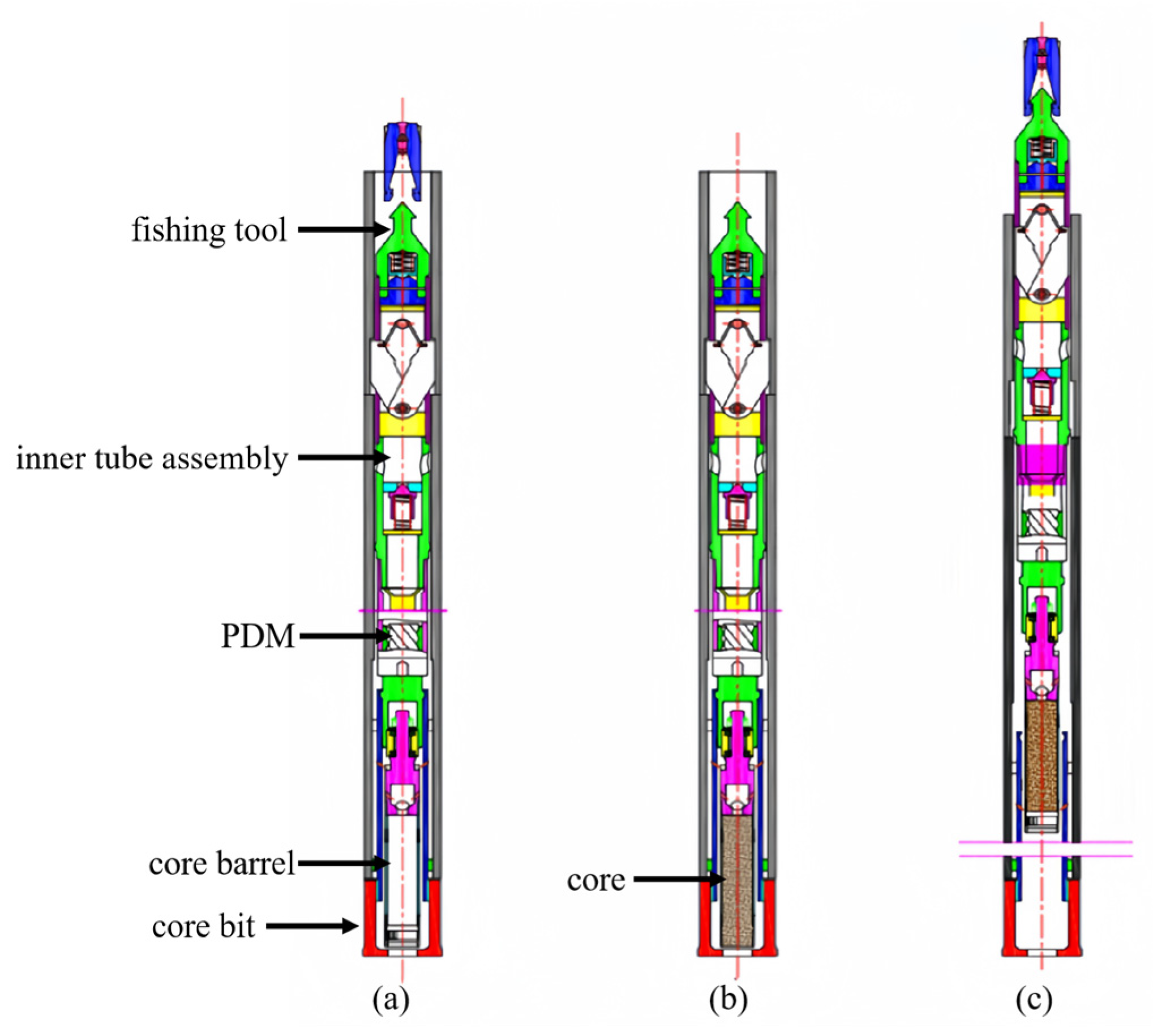
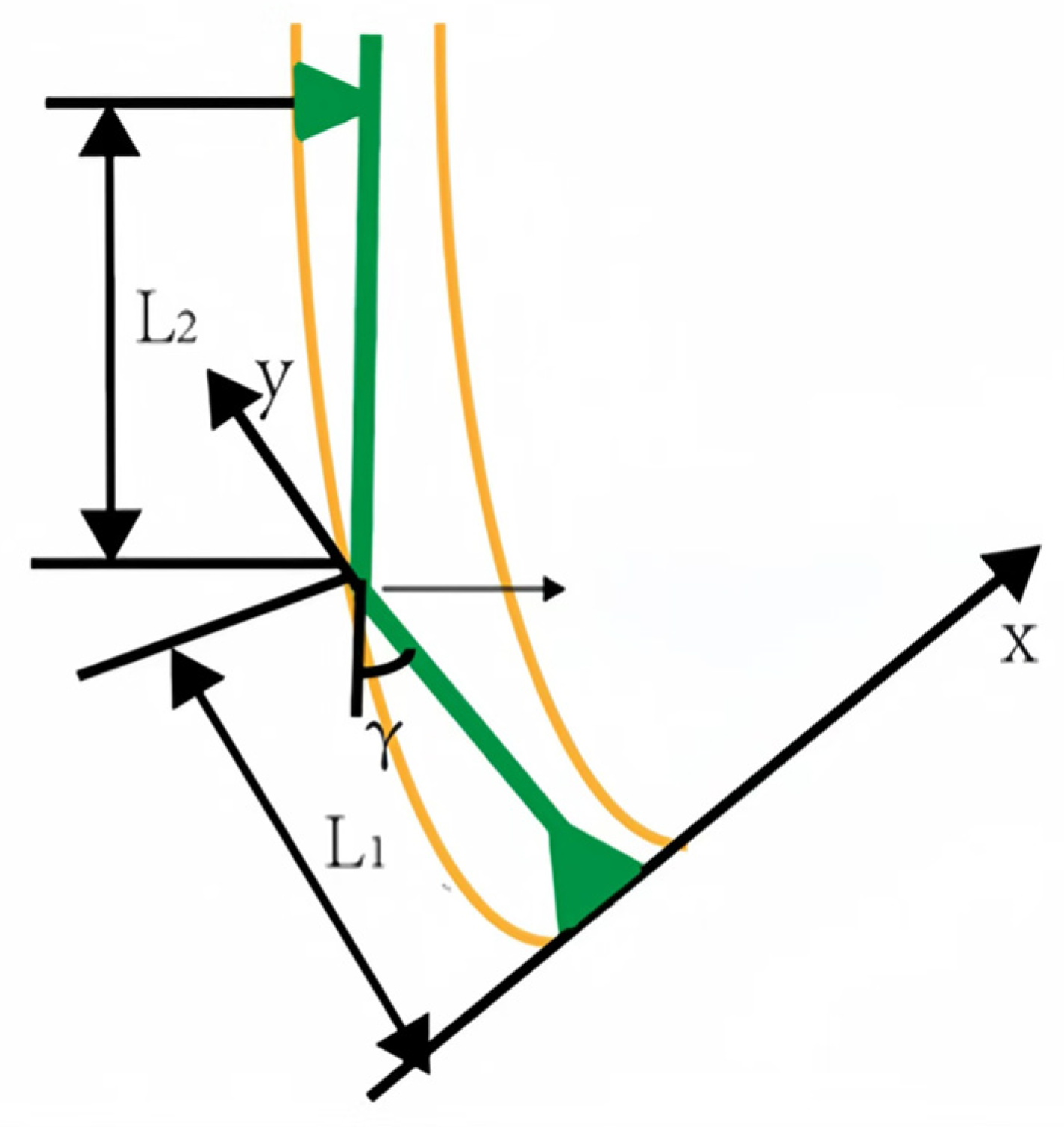

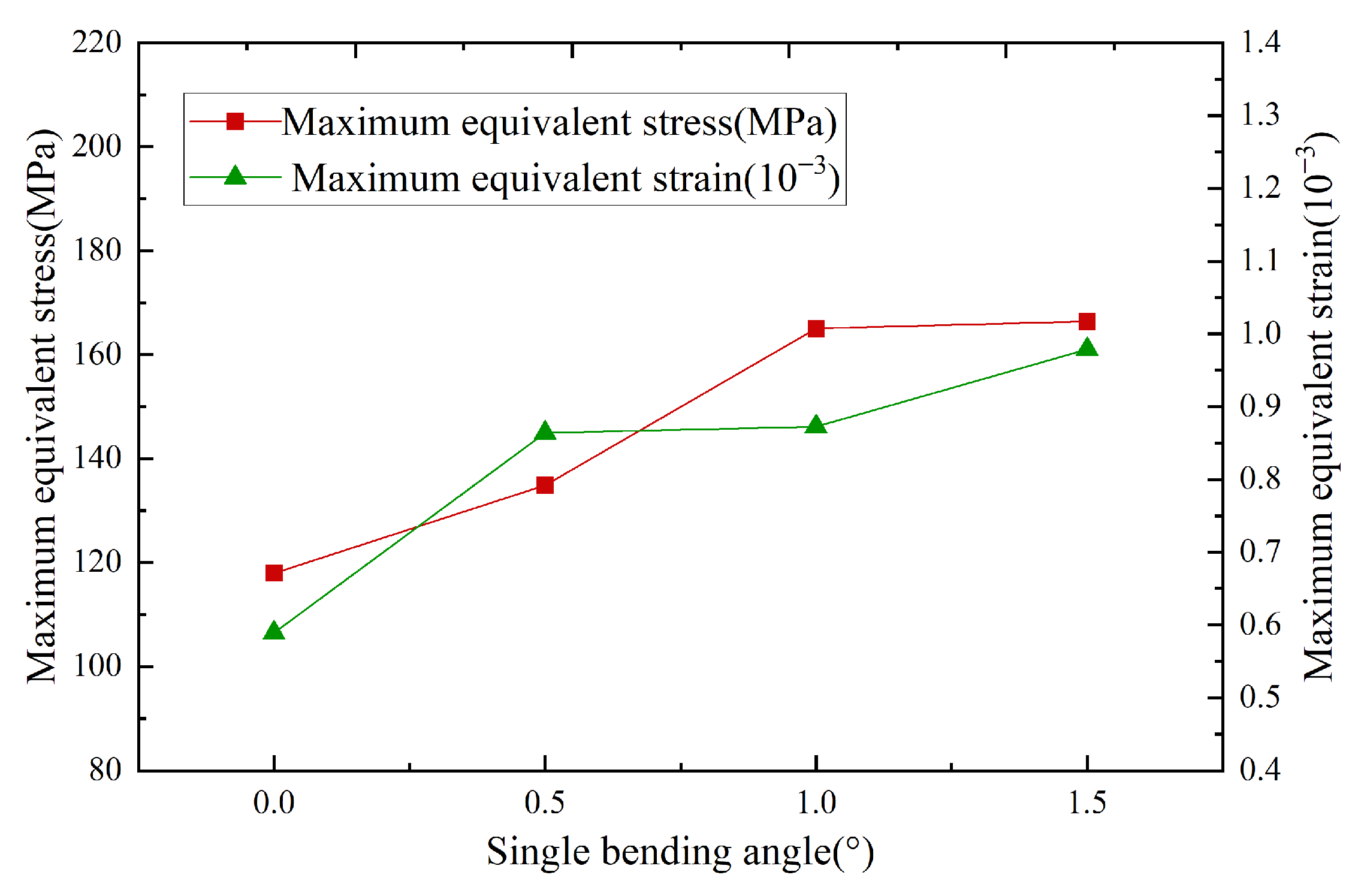

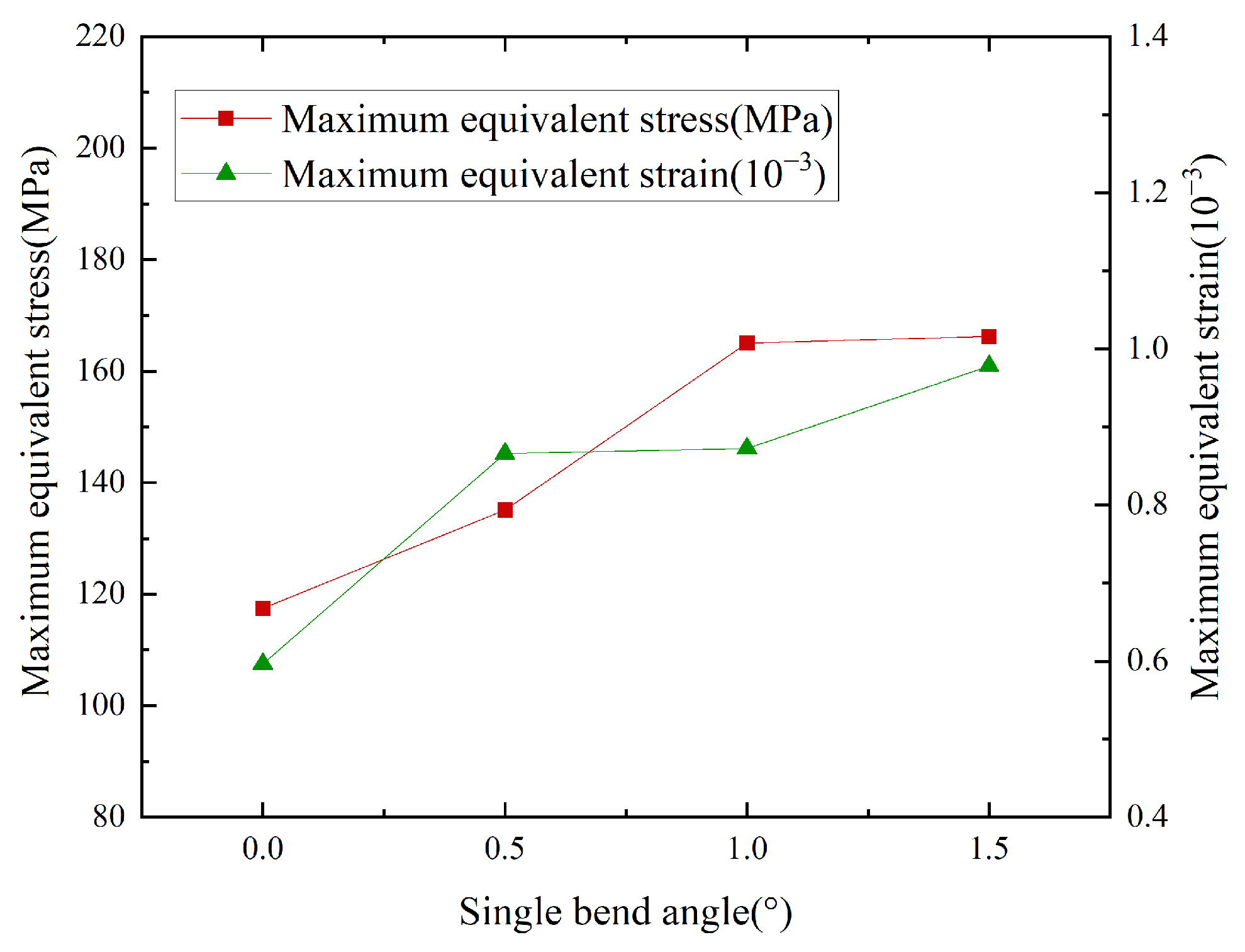
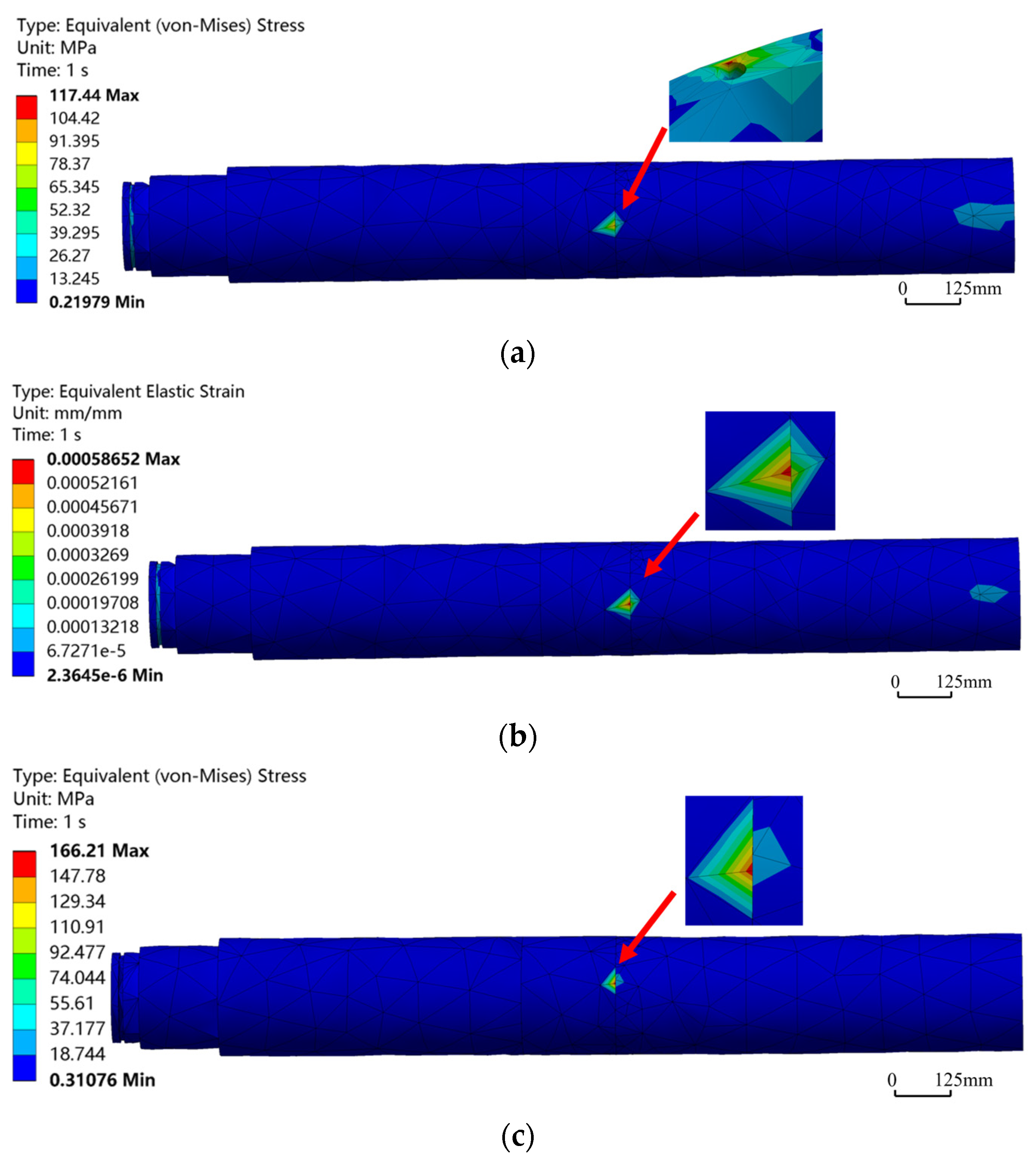
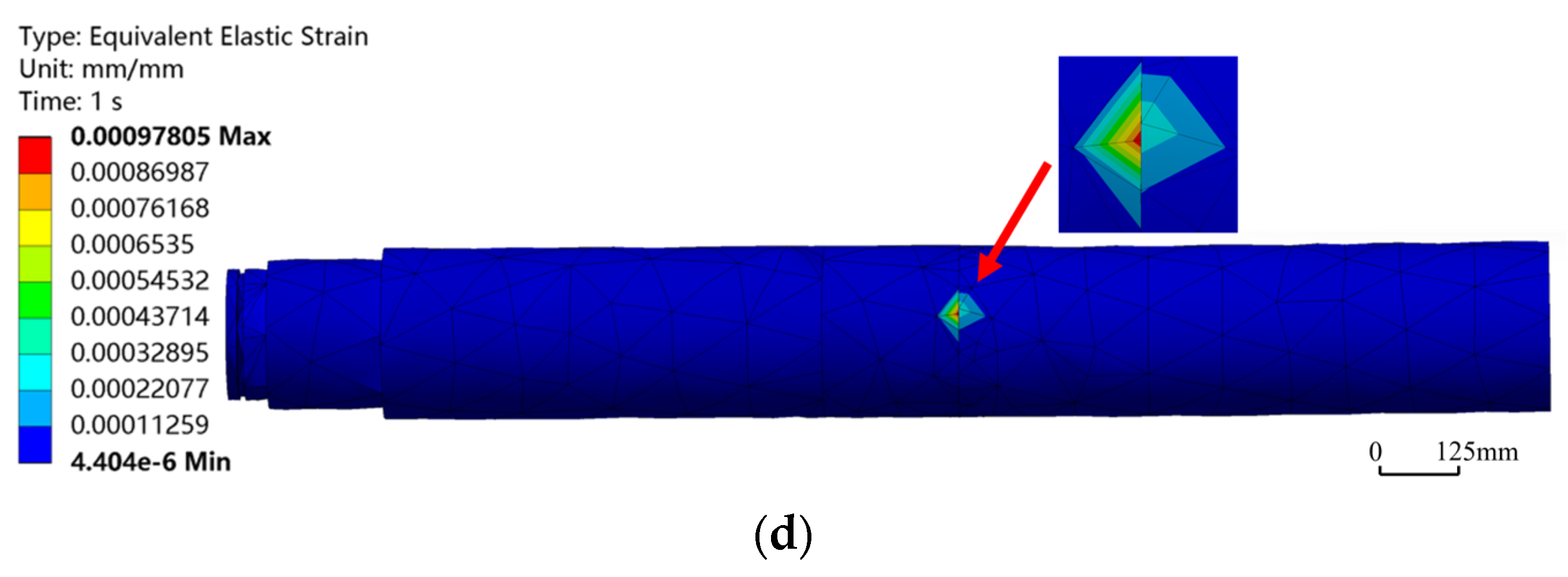
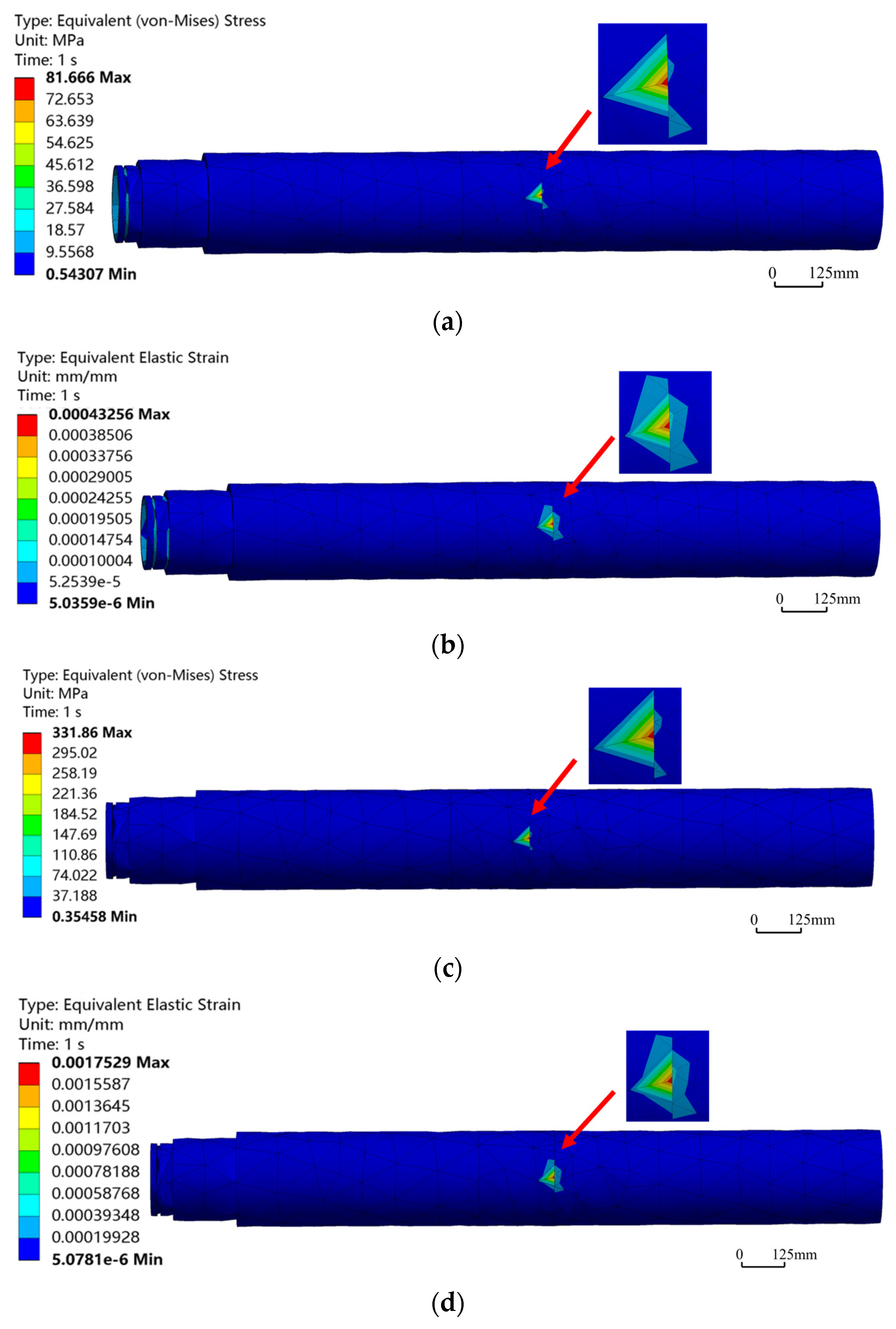
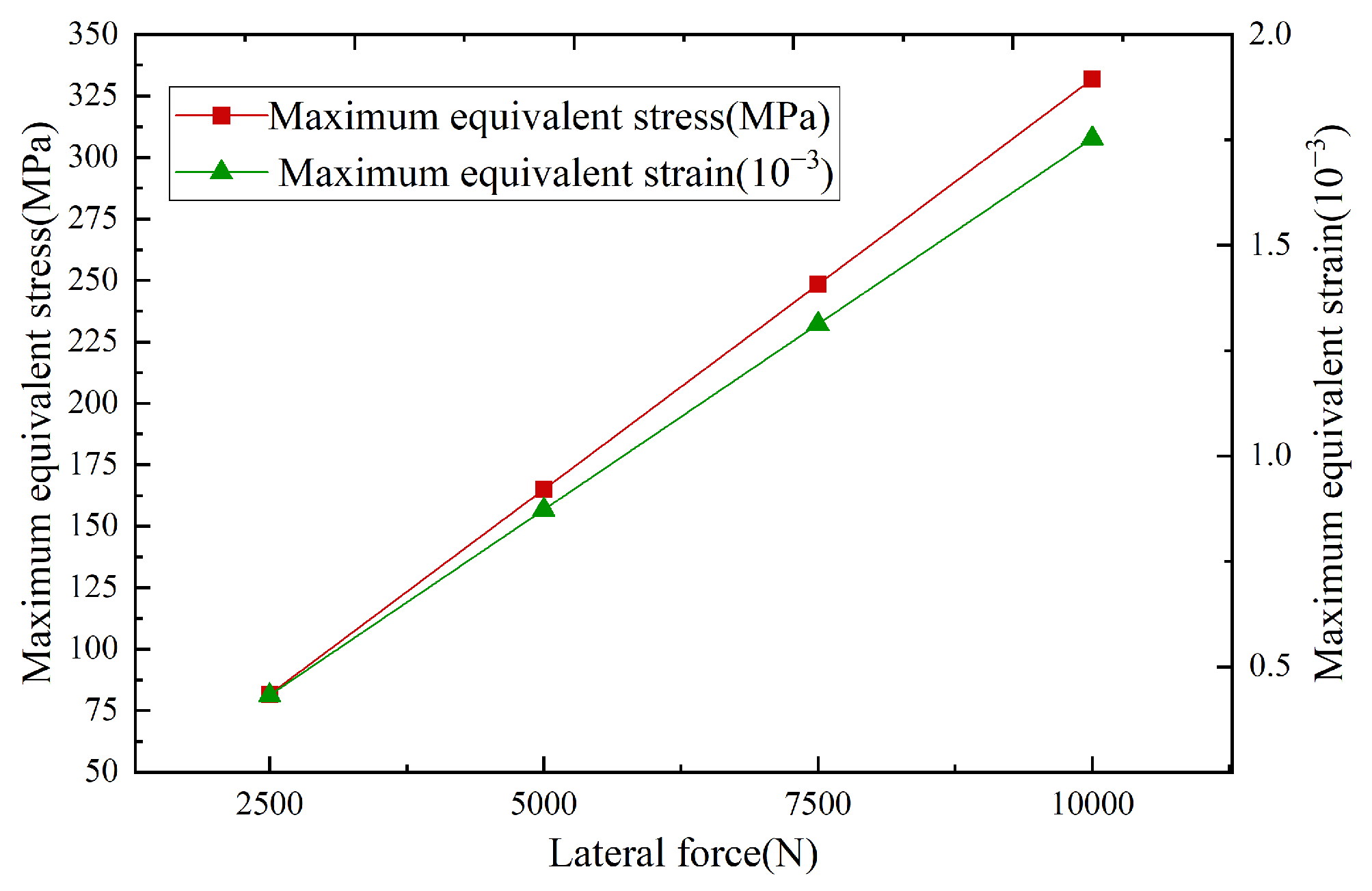
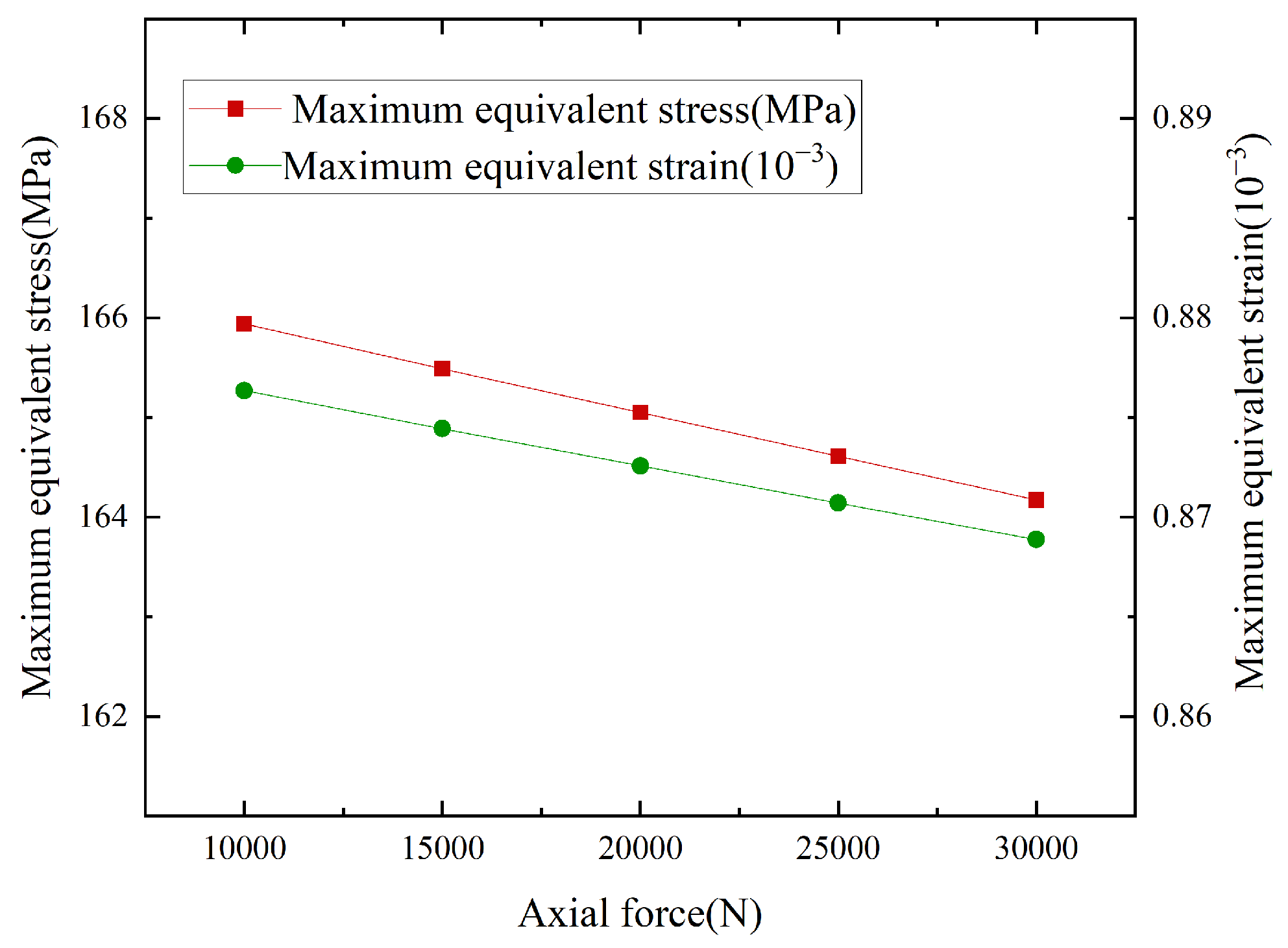



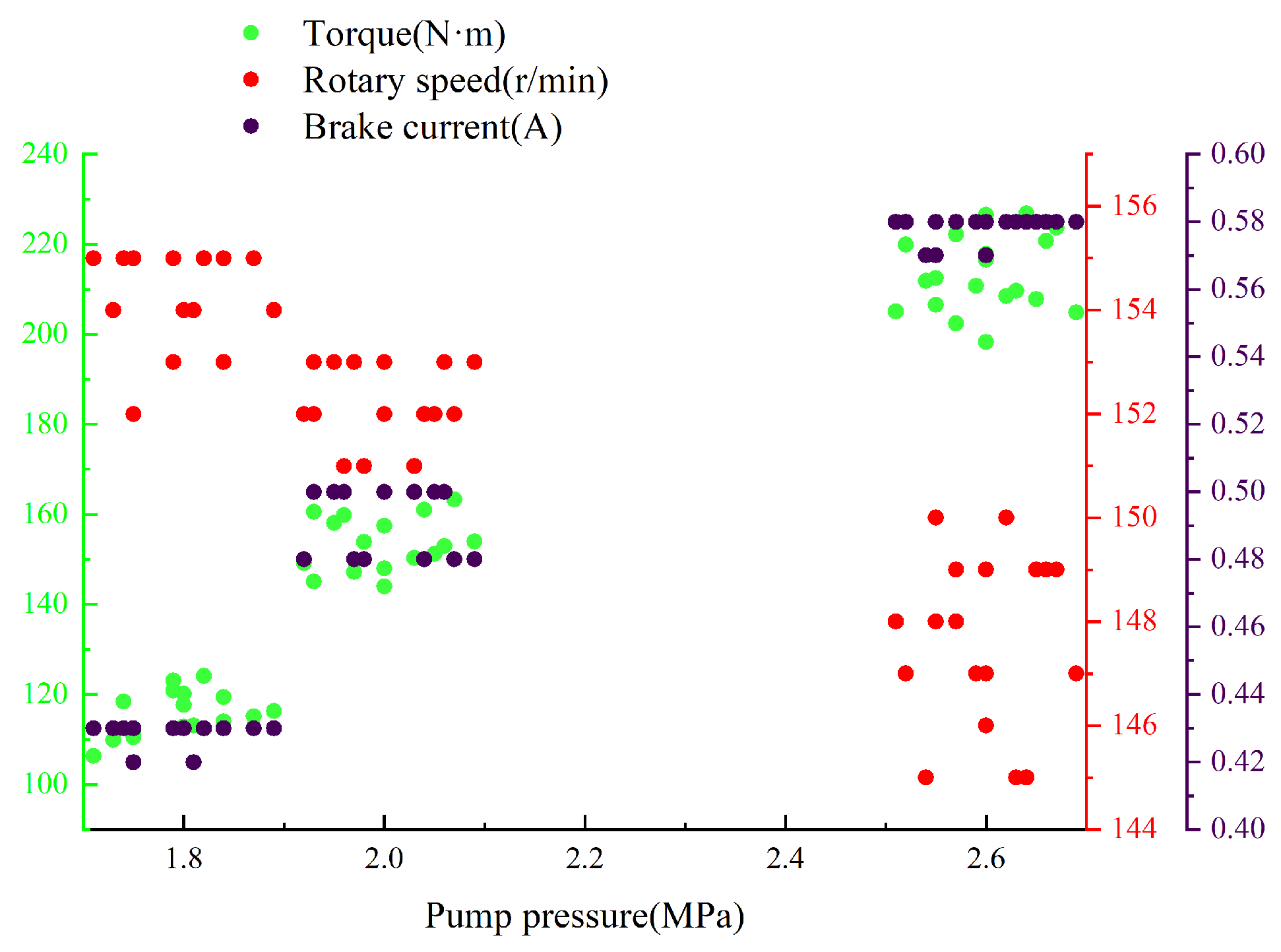
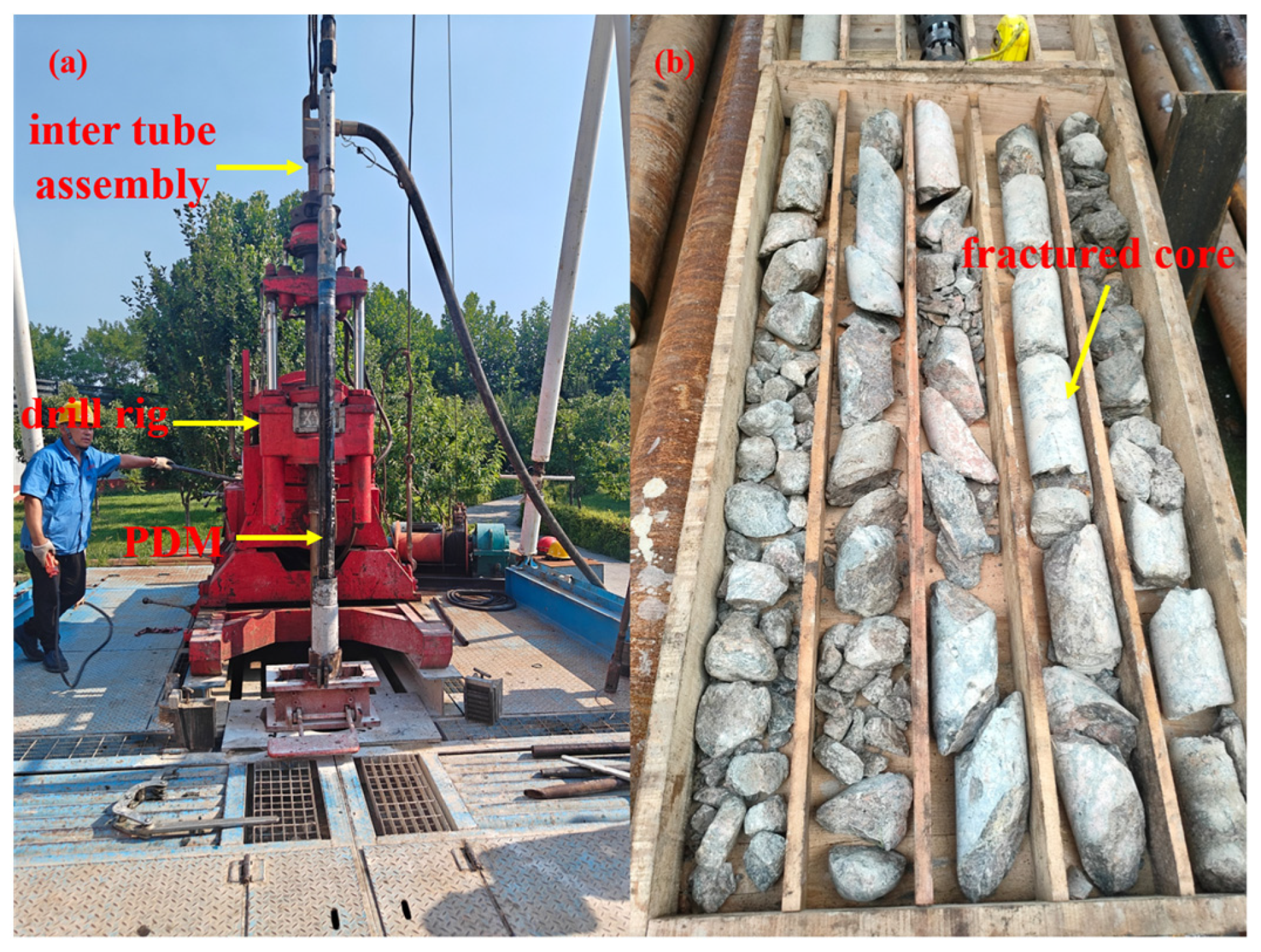
| Type | Core Diameter | OD of Core Bit | Pump Displacement | Pressure Drop | Build-Up |
|---|---|---|---|---|---|
| Devico | 32 mm | 76 mm | ≥1 L·s−1 | 2.5–3 MPa | 9°/30 m |
| Aziwell | 36.4 mm | 76 mm | ≥0.75 L·s−1 | 2–2.5 MPa | 4–9°/30 m |
| Type | Total Length | Core Barrel Length | Core Diameter | OD of Core Bit | Build-Up |
|---|---|---|---|---|---|
| DCDT | 7.3 m | 3 m | 50 mm | 135.5 mm | ≥6°/30 m |
| Type | Inner Diameter | Outer Diameter | Total Length | Adjustable Angle |
|---|---|---|---|---|
| HSBS | 85 mm | 127 mm | 980 mm | 0°, 0.5°, 1.0°, 1.5° |
| Material | Young’s Modulus | Poisson’s Ratio | Yield Strength | Reduction of Area | Shock Absorption Energy |
|---|---|---|---|---|---|
| 42CrMo | 210 GPa | 0.28 | 930 MPa | 45% | 63 J |
| 40Cr | 205 GPa | 0.3 | 785 MPa | 45% | 47 J |
| 35CrMo | 205 GPa | 0.3 | 835 MPa | 45% | 63 J |
| 30CrNiMo | 205 GPa | 0.3 | 785 MPa | 50% | 63 J |
| Drilling Method | Number of Core Runs | Rotary Speed of Rig (r·min−1) | WOB (t) | Pump Displacement (L·s−1) | Drilling Depth (m) | Core Length (m) | Average Drilling Speed (m·h−1) | Core Recovery |
|---|---|---|---|---|---|---|---|---|
| Hybrid drilling | 1 | 40 | 0.5–1.0 | 5.83–6.67 | 0.60 | 0.50 | 1.20 | 83.33% |
| 2 | 60 | 0.5–1.0 | 5.83–6.67 | 0.70 | 0.55 | 1.35 | 78.57% | |
| 3 | 80 | 1.0–1.5 | 5.83–6.67 | 0.95 | 0.80 | 1.50 | 84.21% | |
| 4 | 100 | 1.0–1.5 | 5.83–6.67 | 1.20 | 1.05 | 1.65 | 87.50% | |
| 5 | 120 | 1.0–1.5 | 5.83–6.67 | 1.20 | 1.10 | 1.70 | 91.67% | |
| Slide drilling | 6 | 0 | 1.5–2.5 | 5.83–6.67 | 1.00 | 0.55 | 0.95 | 55% |
| 7 | 0 | 2.0–3.5 | 5.83–6.67 | 1.00 | 0.60 | 1.00 | 60% |
Disclaimer/Publisher’s Note: The statements, opinions and data contained in all publications are solely those of the individual author(s) and contributor(s) and not of MDPI and/or the editor(s). MDPI and/or the editor(s) disclaim responsibility for any injury to people or property resulting from any ideas, methods, instructions or products referred to in the content. |
© 2025 by the authors. Licensee MDPI, Basel, Switzerland. This article is an open access article distributed under the terms and conditions of the Creative Commons Attribution (CC BY) license (https://creativecommons.org/licenses/by/4.0/).
Share and Cite
Wang, Y.; Li, X.; Ma, Y.; Shi, S.; Zhou, Q.; Chou, J.; Chen, J. Design and Experiments of Directional Core Drilling Tool. Appl. Sci. 2025, 15, 11612. https://doi.org/10.3390/app152111612
Wang Y, Li X, Ma Y, Shi S, Zhou Q, Chou J, Chen J. Design and Experiments of Directional Core Drilling Tool. Applied Sciences. 2025; 15(21):11612. https://doi.org/10.3390/app152111612
Chicago/Turabian StyleWang, Yingli, Xiaoyang Li, Yinlong Ma, Shanshan Shi, Qingquan Zhou, Jiabao Chou, and Junda Chen. 2025. "Design and Experiments of Directional Core Drilling Tool" Applied Sciences 15, no. 21: 11612. https://doi.org/10.3390/app152111612
APA StyleWang, Y., Li, X., Ma, Y., Shi, S., Zhou, Q., Chou, J., & Chen, J. (2025). Design and Experiments of Directional Core Drilling Tool. Applied Sciences, 15(21), 11612. https://doi.org/10.3390/app152111612






